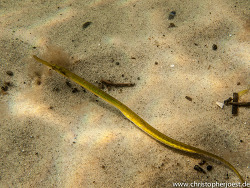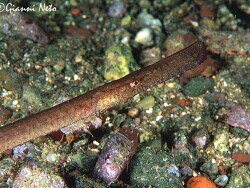Info
Linnaeus, 1758
Usually found along the coasts and estuaries at a temperature range of 8° to 24°C, often associated with Zostera or other vegetation
Synonyms:
Siphonostoma typhle (Linnaeus, 1758)
Siphostoma typhle (Linnaeus, 1758)
Syngnathus argentatus Pallas, 1814
Syngnathus pelagicus Risso, 1810
Syngnathus ponticus Pallas, 1814
Syngnathus pyrois Risso, 1827
Syngnathus rondeletii Delaroche, 1809
Syngnathus rotundatus Michahelles, 1829
Syngnathus thyphle Linnaeus, 1758
Syngnathus viridis Risso, 1810
Syphonostoma typhle (Linnaeus, 1758)
Tiphle hexagonus Rafinesque, 1810
Classification: Biota > Animalia (Kingdom) > Chordata (Phylum) > Vertebrata (Subphylum) > Gnathostomata (Superclass) > Pisces (Superclass) > Actinopterygii (Class) > Syngnathiformes (Order) > Syngnathidae (Family) > Syngnathinae (Subfamily) > Syngnathus (Genus)
Feeding intake.
The fish take a long time to eat at the beginning, before the food is taken up, a close inspection is carried out. After acclimatisation, the offered frozen food is eaten without problems. It should be noted that wild-caught fish behave differently than offspring when it comes to food intake. In the case of offspring, the size of the fish purchased also plays a role in the choice of food.
Usually found along the coasts and estuaries at a temperature range of 8° to 24°C, often associated with Zostera or other vegetation
Synonyms:
Siphonostoma typhle (Linnaeus, 1758)
Siphostoma typhle (Linnaeus, 1758)
Syngnathus argentatus Pallas, 1814
Syngnathus pelagicus Risso, 1810
Syngnathus ponticus Pallas, 1814
Syngnathus pyrois Risso, 1827
Syngnathus rondeletii Delaroche, 1809
Syngnathus rotundatus Michahelles, 1829
Syngnathus thyphle Linnaeus, 1758
Syngnathus viridis Risso, 1810
Syphonostoma typhle (Linnaeus, 1758)
Tiphle hexagonus Rafinesque, 1810
Classification: Biota > Animalia (Kingdom) > Chordata (Phylum) > Vertebrata (Subphylum) > Gnathostomata (Superclass) > Pisces (Superclass) > Actinopterygii (Class) > Syngnathiformes (Order) > Syngnathidae (Family) > Syngnathinae (Subfamily) > Syngnathus (Genus)
Feeding intake.
The fish take a long time to eat at the beginning, before the food is taken up, a close inspection is carried out. After acclimatisation, the offered frozen food is eaten without problems. It should be noted that wild-caught fish behave differently than offspring when it comes to food intake. In the case of offspring, the size of the fish purchased also plays a role in the choice of food.







 spacediver
spacediver




















